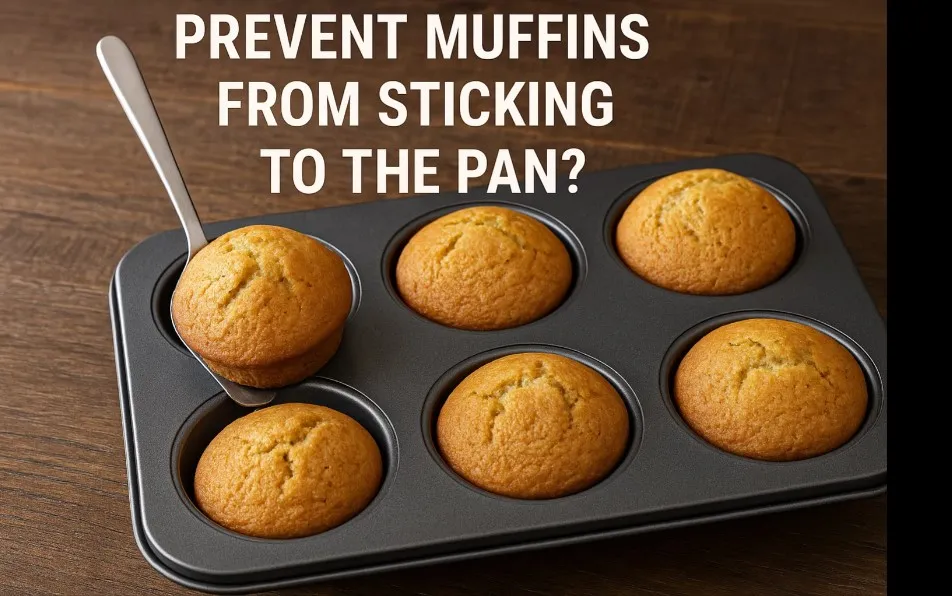To prevent muffins from sticking, grease every crevice of the pan with butter, oil, or baking spray—or use parchment paper liners for foolproof release. For extra security, dust greased cups with a light coating of flour (or cocoa powder for chocolate muffins) to create a non-stick barrier!
When was the last time you baked muffins and didn’t have to scrape at least one out of the pan? (Cue my last Saturday morning!) While most guides talk about greasing or liners, today I’m sharing not just the usual tricks, but eclectic, hands-on fixes straight from trial-and-error, kitchen mishaps, and conversations over coffee. Muffin sticking doesn’t have to be your baking legacy.
1. The Unseen Culprits: Why Muffins REALLY Stick
When it comes to muffin sticking, most people (myself included, at first) tend to blame the greasing method. It’s easy to assume that a little more butter or a different non-stick spray will solve everything. But after a few kitchen mishaps and more than one batch of stubborn muffins, I realized the real story is more complicated. Sometimes, the muffin pan itself is the problem.

Let’s be honest: not all muffin pans are created equal. Old, scratched, or low-quality tins can turn even the best recipe into a sticky disaster. Research shows that high-quality baking tins are essential for non-stick success. If you’re using a pan that’s seen better days, no amount of greasing will truly help. I learned this the hard way—after wrestling muffins out of a worn-out pan, I invested in a new, high-quality muffin pan, and the difference was immediate.
Another culprit? Oven temperature. Even if you’re using a non-stick pan, mismatched or fluctuating oven temperatures can sabotage your efforts. Over-baking is a surprisingly common cause of muffin sticking. I used to leave muffins in “just a bit longer” to make sure they were done, but this only dried them out and made them cling to the pan. Now, I set a timer and trust my oven. If you’re unsure, testing your oven’s accuracy with an oven thermometer can be a game-changer.
Cooling muffins is another step that’s easy to overlook. I used to rush and yank muffins out as soon as they came out of the oven, only to have them fall apart or stick. Industry tips and my own experience now tell me: patience pays off. Allow muffins to cool for 2 to 5 minutes in the pan before removing them. This short wait gives the muffins time to firm up and pull away from the pan’s edges. If they’re still stubborn, running a butter knife gently around the edges can help loosen them without damage.
Proper pan quality and timing make all the difference in baking. – Sarah Kieffer
| Tip | Why It Matters |
|---|---|
| Allow muffins to cool for 2–5 minutes in the pan | Helps muffins firm up and release easily |
| Avoid over-baking | Prevents muffins from drying out and sticking |
2. Greasing Tactics That Actually Work (Confessions of a Non-Perfectionist Baker)

Let’s be honest: greasing muffin tins is one of those steps that seems simple, but it’s easy to get wrong. I’ve had my share of muffins stubbornly clinging to the pan, and after plenty of trial and error, I’ve learned that the best greasing methods aren’t always the most traditional. Here’s what actually works for me—and what research shows can make a real difference.
Butter, Oil, or Non-Stick Spray? Why I Rotate
I don’t stick to just one method for greasing muffin pans. Sometimes I reach for melted butter and a pastry brush, especially if I want that classic, slightly crisp muffin edge. Other times, when I’m in a hurry, I’ll grab a stick of butter and swipe it straight across the pan. For days when I want zero fuss, non-stick spray is my go-to. Each method has its place, and honestly, I rotate based on my mood and the type of muffin I’m making.
The Magic of a Pastry Brush (and the Humble Butter Stick)
Using a pastry brush with melted butter is surprisingly effective for greasing muffin tins. It gets into every nook, especially in pans with quirky shapes. But if I’m feeling impatient, a cold stick of butter works almost as well—just rub it directly onto the pan. Both options beat non-stick spray for those odd-shaped pans that seem designed to trap muffins forever.
Muffin Liners: Silicone, Paper, or Just Grease?
I’ve tested every type of muffin liner out there. High-quality silicone liners are a game changer for chronic stickiness, and paper liners are reliable—if you spray them lightly with non-stick spray first. Old-fashioned butter greasing still holds up, but liners (especially non-stick ones) solve a lot of problems, particularly if you’re baking for a crowd or want easy cleanup.
‘Swap between butter and spray—don’t tie yourself to tradition if it isn’t working.’ – Dorie Greenspan
| Greasing Method | Effectiveness | Best Use |
|---|---|---|
| Melted Butter (Pastry Brush) | Very Effective | Classic muffins, quirky pans |
| Stick of Butter | Effective | Quick greasing, odd shapes |
| Non-Stick Spray | Convenient | Liners, speedy prep |
Research indicates that spraying non-stick spray on cupcake liners makes peeling muffins out much easier. Meanwhile, using melted butter with a pastry brush ensures even coverage and helps prevent sticking, especially for pans with lots of corners. I’ve found that rotating between these greasing methods keeps my muffins unstuck—and my mornings a little less stressful.
3. Prevention Power-Ups: Unexpected Tips & MacGyver Moves for Muffin Pan Success
When it comes to muffin pan tips, sometimes the best solutions aren’t the ones you find in a standard recipe. Over the years, I’ve learned that baking success often comes down to a little improvisation—especially when you’re staring down a stubborn, sticky muffin pan. As Stella Parks puts it,
‘Improvisation in baking isn’t just allowed—sometimes it’s required.’
Let’s talk about a few unconventional, yet surprisingly effective, muffin pan preparation tricks that can make the difference between a non-stick muffin and a frustrating clean-up session.
- Fill Empty Muffin Cups with Water
This one sounds odd, but research shows that filling any unused muffin cups with water helps distribute heat more evenly throughout the pan. It’s a small step that can prevent the edges of your muffins from burning and, in turn, helps with sticking prevention. Even heat means less risk of over-baked, stuck-on muffins—especially if you’re only making a half batch. - Egg Rings or Biscuit Cutters as Makeshift Muffin Pans
Ever found yourself ready to bake but short on muffin pans? Egg rings or biscuit cutters can step in as emergency alternatives. Just set them on a baking sheet, fill with batter, and bake as usual. It’s not traditional, but it works in a pinch and keeps your baking success on track. - Tray of Water in the Oven
Here’s a wild card: place a shallow tray of water on a lower rack in your oven. This adds a touch of moisture to the air, which can help prevent muffin liners from sticking to the finished product. But don’t go overboard—too much moisture can lead to soggy bottoms, so use this trick sparingly.
These non-traditional muffin pan tips might seem a bit out there, but sometimes, that’s exactly what you need. Studies indicate that pan alternatives and moisture control are underappreciated strategies for sticking prevention. If you’re serious about muffin pan preparation, don’t be afraid to experiment with these MacGyver moves. Sometimes, the best baking success comes from thinking outside the (muffin) box.
Set Those Muffins Free—Your Next Batch Awaits
If there’s one thing I’ve learned on my baking journey, it’s that every muffin—whether it slides out perfectly or clings to the pan for dear life—teaches me something new. Baking mishaps, like muffin sticking, aren’t failures. They’re simply part of the process, and sometimes, they’re the best teachers. Each batch gives us a chance to experiment, adapt, and improve. In fact, research shows that consistent experimentation is key to preventing future sticking. The more I bake, the more I understand what works for my kitchen, my pans, and my favorite muffin recipes.

I used to get frustrated when muffins stuck, thinking it was a sign I’d done something wrong. But now, I see it differently. A stuck muffin is just an excuse to try again—maybe with a new greasing method, a different liner, or a tweak to the recipe. Sometimes, I’ll use melted butter and a pastry brush to grease the tin, or I’ll reach for a non-stick spray.
Other days, I experiment with silicone trays or high-quality liners. And yes, I’ve learned to let muffins cool for a few minutes before trying to remove them, and I always keep a butter knife handy to gently loosen the edges.
Patience and preparation matter more than perfection. Baking success isn’t reserved for professionals. Anyone can achieve it with a little practice and a willingness to adapt. Studies indicate that patience—waiting those extra few minutes before removing muffins from the pan—can make all the difference. And sometimes, even with all the right baking tips, a muffin will still stick. That’s okay. As the King Arthur Baking Company wisely says:
“Every muffin that sticks is just research for your next great batch.”
So, don’t let a stubborn muffin pan keep you from baking. Embrace the process, learn from each attempt, and remember that every batch is a step closer to baking success. Whether you’re perfecting classic muffin recipes or trying something new, your next batch awaits—stick or no stick. Keep experimenting, keep enjoying the journey, and most importantly, set those muffins free.
Frequently Asked Questions For How to prevent muffins from sticking to the pan?
Can I use cooking spray instead of butter?
Yes! Cooking spray works well, but make sure to coat the entire cup, including the top edges.
Why do my muffins stick even with liners?
Some liners are low-quality. Try parchment or silicone liners, or lightly grease the inside of the liner.
Are silicone muffin pans better?
They’re great for non-stick baking, but they can make muffins less crispy. For crisp edges, use metal pans.
How do I clean a sticky muffin pan?
Soak it in warm, soapy water, then gently scrub. Avoid steel wool, which can damage non-stick coatings.
“Baking is both an art and a science—getting it right means paying attention to the little things.” – Mary Berry
Extra Tips for Perfect Muffins
- Use room-temperature batter – Cold batter can stick more.
- Don’t overfill cups – Muffins that rise too much can glue themselves to the pan.
- Try a light dusting of sugar – For a crisp top that releases easily.
Conclusion
Preventing muffins from sticking is all about preparation—greasing well, choosing the right pan, and not overbaking. With these simple tips, you’ll never have to scrape stuck muffins again!
Happy baking, and may all your muffins pop out perfectly.
“The secret to great baking is patience and practice—every mistake is just a lesson for next time.” – Paul Hollywood

